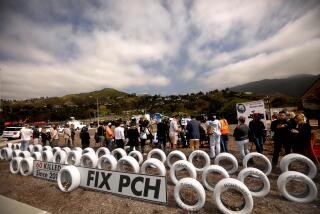Checkpoints Put Brakes on Cities’ Drunk Drivers
- Share via
On a night when many holiday revelers will honor the year by hoisting one too many, police in Oxnard and Port Hueneme are confident that fewer inebriated celebrants will drive in their cities.
That wasn’t the case four years ago, when Oxnard had one of the state’s worst records for alcohol-related crashes resulting in injuries. With the help of two state grants, the city has reduced such incidents by 43.5% since 1993 and officials expect the trend to continue.
Oxnard traffic officers say the grants allowed them to put in place monthly checkpoints and an effective prevention program aimed at alcohol-impaired drivers.
“Out of 1,000 cars, we used to get 20 to 25,” said Don Mulville, Oxnard’s traffic coordinator. “Now we are lucky to get one.”
Mulville said the checkpoints in Oxnard and Port Hueneme are among the most fully staffed in the state. They are manned by 12 officers, 12 civilian traffic cadets and 10 to 12 Explorer Scouts. A motor home at the checkpoint houses a booking unit and a forensic specialist who tests suspects.
“This is more efficient because we do it all on the scene and nobody leaves,” Mulville said. “Officers used to have to take people down to the station and test them and it would take a long time, decreasing our numbers at the checkpoints.”
State officials tracking checkpoint programs agree that the approach is effective.
“That’s about the quickest way you can do it in terms of keeping people on the scene--it’s a compact operation,” said Ken Milton, a California Highway Patrol spokesman.
According to Ken Klopman, an Oxnard police officer who helped raise money for the program, the checkpoints were made possible by two grants from the California Office of Traffic Safety.
A $23,000 grant in 1995 helped buy the motor home, cones and barricades. The second grant--a two-year award for $380,000--included money for a prevention program administered by the Ventura County Department of Alcohol and Drug Programs.
Since that grant took effect, alcohol-related crashes in Oxnard and Port Hueneme have decreased by 25.6% from 109 in 1996 to 81 in 1997. In 1993, the cities experienced 150 such crashes.
While the sobriety tests have been a useful deterrent, Klopman said the prevention program also deserves some credit. According to Community Program Coordinator Sharon O’Hara, a group of 25 volunteers has taken several steps to reduce irresponsible drinking and serving of alcohol in Oxnard and Port Hueneme.
The coalition has participated in bar licensing meetings, staffed booths at community events and counseled bar owners on the dangers of serving customers too much.
According to O’Hara, past programs have attempted to educate the community without trying to change the environment in which alcohol is served.
“We are hoping that over time, with the community involvement, it will become less socially acceptable to drive impaired, “ she said.
More to Read
Sign up for Essential California
The most important California stories and recommendations in your inbox every morning.
You may occasionally receive promotional content from the Los Angeles Times.










